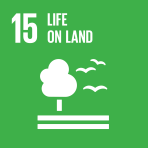- Home
- Sustainable Development Goals
- Life on Land
 Life on Land
Life on Land
Acknowledgements
Mar 2025
Chapter
The following publication was prepared under the guidance of the United Nations Economic Commission for Europe (UNECE) Forest and Bioeconomy Section in response to the request by the Republic of Moldova for support for the modernization of the network of forest nurseries. The study was prepared with the use of funds from the Regular Programme of Technical Cooperation. We acknowledge the authors Liviu Nichiforel and Ciprian Palaghianu from the Read More
Forest Landscape Restoration in the Republic of Moldova
Exploring the Potential for Forest Reproductive Material Production
Mar 2025
Book
The study was developed by the United Nations Economic Commission for Europe (UNECE) in response to the request of the Republic of Moldova to improve the forest reproductive material (FRM) sector in the Republic of Moldova. The study includes an overview of FRM production in selected European countries assesses Moldova's FRM production capacity and identifies challenges such as outdated technology and labour shortages. It highlights the need fo Read More
Executive summary
Mar 2025
Chapter
The Republic of Moldova has one of the lowest forest covers in Europe with only 461.6 thousand ha or slightly more than 11 per cent of the total land area. While several national strategic plans and policy documents set the targets for further forest area expansion to 15-17 per cent and numerous afforestation projects leading to a constant increase of the forest area from 1990 to 2020 by more than 60 thousand ha these targets have been met only parti Read More
Abstract
Mar 2025
Chapter
The following publication was prepared under the guidance of the UNECE Forest and Bioeconomy Section in response to the request of the Republic of Moldova to improve the forest reproductive material (FRM) sector in the Republic of Moldova. The study includes an overview of FRM production in selected European countries assesses Moldova's FRM production capacity and identifies challenges such as outdated technology and labour shortages. It hi Read More
Policy Guidelines: Low Carbon Construction in Cities
Reducing Construction's Carbon Footprint With Sustainable Wood Products
Mar 2025
Book
This publication provides an overview for policymakers and decision takers on how sustainably grown wood can contribute to the efforts of cities to reducing the carbon footprint in the built environment. The document emphasizes the carbon and other technical advantages of an increased use of wood as low carbon construction material in cities in the ECE region and beyond. It further provides guidance on how various actors could contribute to facilitat Read More
Foreword
Main Title:
Forest Products Annual Market Review 2023-2024
Dec 2024
Chapter
Forests are dynamic ecosystems that play a crucial role in providing essential services such as biodiversity conservation and climate regulation. They are vital for many economies offering a wide range of products like softwood wood-based panels pulp paper and wood energy. With the increasing global population and demand for these products and other services the challenge lies in optimizing and balancing short-term economic gains with long-term sustainability
Acknowledgements
Main Title:
Forest Products Annual Market Review 2023-2024
Dec 2024
Chapter
The UNECE/FAO Forestry and Timber Section expresses its deep gratitude to everyone who contributed to this edition of the Forest Products Annual Market Review.
No more items...
